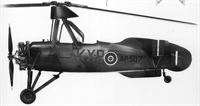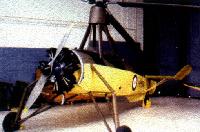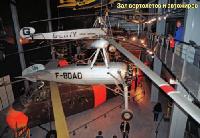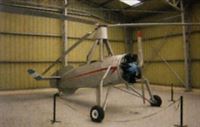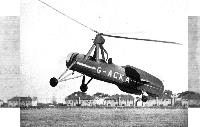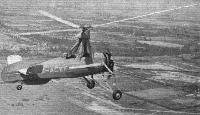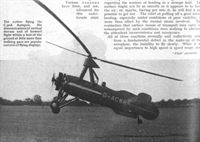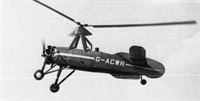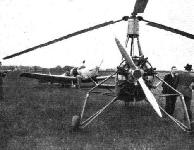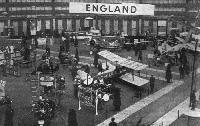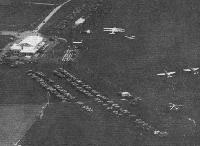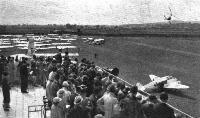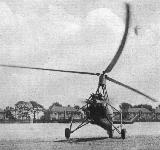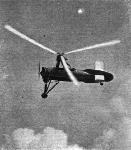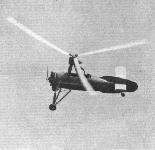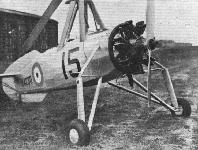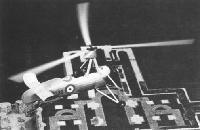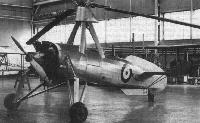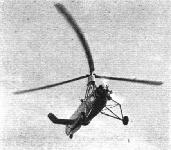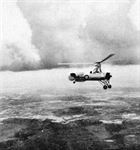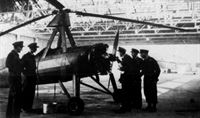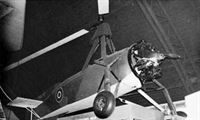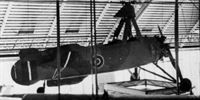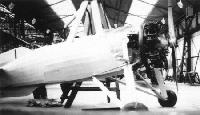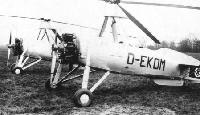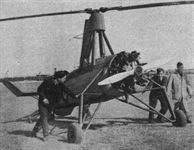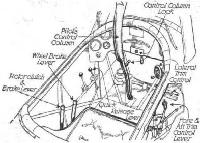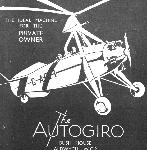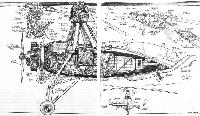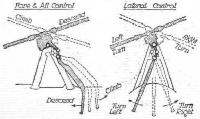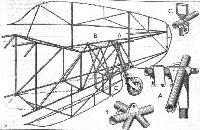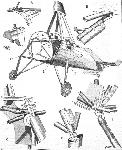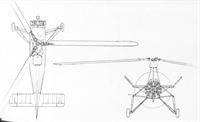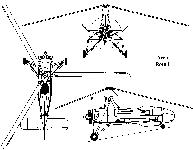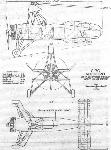
Описание
Страна : Великобритания
Год : 1932
Автожир
Двухместный многоцелевой автожир
Варианты
- Cierva/Avro - C.30A / Rota - 1932 - Великобритания
- Liore et Olivier - C.34 - 1936 - Франция
C.30A / Rota
Ближний разведчик, корректировщик, аппарат связи. Бескрылый автожир смешанной конструкции. Имел неубирающееся шасси с хвостовым колесом. Был спроектирован в КБ фирмы "Сиерва аутоджиро" под руководством X. Де ля Сиервы.
Опытный образец автожира С.30 испытывался в 1932 г.
Усовершенствованный С.30А со складывающимся ротором запустили в серийное производство на заводе "Авро" в Манчестере в 1934 г. Автожир выпускался также в Германии (заводом "Фокке-Вульф", только как гражданский), во Франции (заводом фирмы "Лиор э Оливье") и в Дании (в мастерских ВВС).
Всего выпущено 183 экз., в т. ч. 78 военных.
С.30А в разных модификациях состоял на вооружении в Великобритании (с июня 1934 г.), в Бельгии (с мая 1935 г.), во Франции (с 1937 г.), в Дании (с 1936 г., как IM), в Швеции (с конца 1939 г.). Экипаж - 2 чел. Двигатель в зависимости от модификации. Вооружения нет.
Известны следующие военные варианты:
- Авро "Рота" I, выпускался для британских ВВС в 1934-36 гг., мотор "Дженет Мэйджор" I;
- LeO С.30, французский вариант с мотором "Дженет Мэйджор";
- LeO C.301, французский вариант с мотором Сальмсон 9Ne.
Английские автожиры с конца 1938 г. были законсервированы, но в сентябре 1939 г. вновь поставлены в строй. В 1941-42 гг. мастерские ВВС в Даксфорде собрали из запчастей дополнительно пять аппаратов. Кроме того, в 1939-41 гг. реквизировали восемь С.30А гражданского варианта. Все они использовались для связи и калибровки РЛС.
Французские машины в мае 1940 г. служили в пяти разведывательных эскадрильях ВВС и одной эскадрилье морской авиации. В ходе боевых действий они ограниченно применялись для связи и корректировки огня артиллерии. Впоследствии несколько автожиров эксплуатировались авиацией правительства Виши.
Датские IM в боевых операциях не участвовали. В апреле 1940 г. их захватили немцы, но не эксплуатировали. Единственный бельгийский автожир списали в 1938 г.
В Швеции морская авиация реквизировала в 1939 г. несколько гражданских автожиров. Они патрулировали побережье, искали плавающие мины, осуществляли снабжение отдаленных наблюдательных пунктов.
Выпуск военных автожиров фирма "Авро" прекратила в ноябре 1936 г. Во Франции производство велось до конца 1939 г.
"Рота"I||
Диаметр несущего винта:||11,25 м
Длина:||6,0 м
Моторы, количество х мощность:||1x140 л.с.
Взлетная масса, максимальная:||862 кг
Максимальная скорость:||177 км/ч
Практический потолок:||2440 м
Дальность:||400 км
Описание:
- C.30A / Rota
- Cierva (автожиры X. Сиервы)
- Flight, November 1933
A NEW AUTOGIRO - Flight, June 1934
Cierva Autogiro C. 30 P - Flight,August 1934
ROTATING-WINGED FLIGHT - Flight, April 1936
MODERN LIGHT AIRCRAFT REVIEWED
Фотографии
-
Мировая Авиация 90
Регистрационный номер: DR623 [2], G-ACWH [2], G-AHLE [2] Этот аппарат Avro Rota Mk I состоял в 1943-1944 годах в британской 529-й эскадрилье. Он использовался, главным образом, для калибровки береговых РЛС. В боевых действиях не участвовал, хотя и был практически неуязвим для вражеских истребителей благодаря своей исключительно высокой маневренности.
-
Aeroplane Monthly 1974-12 / Cierva C.30A /Preservation Profile/ (20)
Регистрационный номер: AP507 [4], G-ACWP [4]
-
Моделист-Конструктор Ближние разведчики, корректировщики и штурмовики Второй мировой войны
Автожир Авро "Рота" I в Имперском военном музее, Даксфорд (Англия)
-
Air Enthusiast 2003-07 / N.Price - Honouring a pioneer
Newly-built Cierva C.30A reproduction 'XVU.1-0' at the Spanish Air Force Museum at Cuatro Vientos.
-
Air Enthusiast 2003-07 / N.Price - Honouring a pioneer
Регистрационный номер: K4232 [5], SE-AZB [5] The RAF Museum's example, K4232, before its trip to Spain.
-
Aeroplane Monthly 1998-10 / M.Oakey, T.Harmsworth - Vintage news
Регистрационный номер: K4235 [5], G-AHMJ [5] Soon to depart: Shuttleworth’s Cierva C.30A K4235.
-
Авиация и Космонавтика 2014-12 / М.Никольский - Музей в Ле Бурже /Музей/
Регистрационный номер: F-BDAD Зал вертолетов и автожиров
Другие самолёты на фотографии: Cierva/Avro C.8 / C.9 - Великобритания - 1926
-
My photos 2011-01 / Italy - Milano - Museo Nazionale della Scienza e della Tecnologia Leonardo da Vinci
Регистрационный номер: I-CIER -
Aeroplane Monthly 1999-05 / M.Oakey, T.Harmsworth - News
Dr Lopez Ruiz, a member of the project’s technical committee, poses with the C.30.
-
Aeroplane Monthly 1999-05 / M.Oakey, T.Harmsworth - News
This brand-new Cierva C.30 Autogiro, built in tribute to rotorcraft pioneer Juan de la Cierva, lifted into Spanish skies for the first time on February 3, 1999.
-
Aeroplane Monthly 1999-05 / M.Oakey, T.Harmsworth - News
Test pilot Lt-Col Fernando Iglesia brings the Spanish Air Force-liveried Cierva in for a low pass at Albacete.
-
Aeroplane Monthly 1999-09 / M.Oakey, T.Harmsworth - News
Регистрационный номер: LV-FBL Avro-built C.30A LV-FBL in Buenos Aires, restored but with no markings.
-
Flight 1933-08 / Flight Advertisements
Регистрационный номер: G-ACFI [3] -
Aeroplane Monthly 1990-10 / B.Elliott - The flying squad (1)
Регистрационный номер: G-ACIN [6] Cierva C.30P G-ACIN was used by the Metropolitan Police for trials in 1934.
-
Flight 1935-03 / Flight Advertisements
Регистрационный номер: G-ACIN [6] -
Aeroplane Monthly 1989-06 / Personal album. Civil
Регистрационный номер: G-ACIN [6] Cierva C.30P G-ACIN, built late in 1933 by Avro and seen here at Cierva s base at Hanworth. Registered in January 1934, it remained with the Cierva company until scrapped in 1938.
-
Aeroplane Monthly 1989-06 / Personal album. Civil
Регистрационный номер: G-ACIN [6] Another view of Cierva C.30P G-ACIN, about to be flown by Juan de la Cierva at Hanworth. Sister aircraft G-ACIO became the first autogiro to land on a ship in Europe on March 7, 1934, when Cierva landed on the Spanish Navy's Dedalo moored off Valencia.
-
Aeroplane Monthly 1974-02 / B.Martin - Britain's civil aircraft register
Регистрационный номер: G-ACIN [6] G-ACIN was a pre-production Cierva C.30P, one of a batch of three constructed by A. V. Roe and Co. Ltd at their Manchester works. A C of A was granted on January 2, 1934, and it became the Cierva company's Hanworth - based demonstrator until it was finally scrapped in 1938.
-
Flight 1935-05 / Flight
Регистрационный номер: G-ACIO SHEFFIELD WEDNESDAY AT WEMBLEY ON SATURDAY: The C.30 Autogiro used by the London police for supervising traffic flies low over Wembley Stadium during the football Cup Tie between West Bromwich Albion and Sheffield Wednesday.
Cierva C.30 G-ACIO on traffic duty above Wembley Stadium on the occasion of the Cup Tie between West Bromwich Albion and Sheffield Wednesday in April 1935. -
Flight 1933-11 / Flight
Регистрационный номер: G-ACKA [4] -
Jane's All the World Aircraft 1980 / Encyclopedia of Aviation - Aircraft A-Z - v2
Регистрационный номер: G-ACKA [4] Cierva C.30P Mk II.
-
Flight 1934-06 / Flight
Регистрационный номер: G-ACKA [4] ALLEZ OOP! The new C.30 P Autogiro leaps off the ground almost like a circus horse, and no doubt the extra power of the 7-cylinder "Genet Major" engine has a lot to do with this. Mr. H. A. Marsh, test pilot to the Autogiro Co., is an adept at demonstration, and in this case showed conclusively that this latest Autogiro has a far better take-off than the majority of other aircraft. Access to the passengers' cockpit is much better in this model, the side of the fuselage by the front cockpit having been made like a roll-top desk so that it can readily be lowered.
-
Flight 1936-01 / Flight Advertisements
Регистрационный номер: G-ACUT -
Aeroplane Monthly 1990-06 / Cierva C.30A HM580/G-ACUU /Preservation Profile/
Регистрационный номер: G-ACUU [6], HM580 [6] G-ACUU with rotor blades folded and hub cover removed at Staverton.
-
Aeroplane Monthly 1990-06 / Cierva C.30A HM580/G-ACUU /Preservation Profile/
Регистрационный номер: G-ACUU [6], HM580 [6] Guy Baker flying G-ACUU at Fairwood Common in August 1950.
-
Aeroplane Monthly 1990-06 / Cierva C.30A HM580/G-ACUU /Preservation Profile/
Регистрационный номер: G-ACUU [6], HM580 [6] The same aircraft at the Fifty Years of Flying display at Hendon in July 1951.
-
Aeroplane Monthly 1990-06 / Cierva C.30A HM580/G-ACUU /Preservation Profile/
Регистрационный номер: G-ACUU [6], HM580 [6] Cierva C.30A G-ACUU at Hamble circa 1937 where it was on strength with the Air Service Training fleet.
-
Aeroplane Monthly 1983-02 / L.Curtis - Flying for all
Регистрационный номер: G-ACWF [6] 'Jump start' by C.30A G-ACWF on Hounslow Heath, July 1936 with H A Marsh piloting.
Half a dozen Cierva C.30s were used by the CAG and those that survived were impressed into RAF service. Twelve were to survive the war but none are flying today. -
Flight 1936-07 / Flight
Регистрационный номер: G-ACWF [6] The C.30 Autogiro with two-bladed rotor and autodynamic rotor head. The view on the left, showing the take-off, gives the impression that the machine is almost without visible means of support. Mr. H. A. Marsh was the pilot.
-
Flight 1935-01 / Flight Advertisements
Регистрационный номер: G-ACWF [6] -
Flight 1935-05 / Flight
Регистрационный номер: G-ACWF [6] Although representing only another stage in the gradual development of the Autogiro, the C.30 direct-control model has now been in successful use for several years
-
Flight 1934-08 / Flight
Регистрационный номер: G-ACWF [6] UNSTALLABLE: The Cierva "Autogiro" built by A. V. Roe & Co., Ltd., will be exhibited at Copenhagen, and another machine will be available at the aerodrome. The engine is a 7-cyl. Siddeley "Genet Major."
-
Flight 1936-07 / Flight
Регистрационный номер: G-ACWF [6] MORE JUMPS: A vertical take-off by the latest C.30 Autogiro. Various components of this experimental machine are heavier than they need be, with the result that the gross weight is the same as that of the ordinary C.30 fully loaded. In spite of this, jumps of forty feet in height have been made.
-
Aeroplane Monthly 1985-06 / N.Ewart - When flying was still an adventure (3)
Visiting aircraft at Croydon in the late Thirties.
Другие самолёты на фотографии: Armstrong Whitworth Scimitar / A.W.16 / A.W.35 - Великобритания - 1931De Havilland Dragon Rapide / Dominie / D.H.89 - Великобритания - 1934Saunders-Roe Cloud / A.19 - Великобритания - 1930Spartan Cruiser - Великобритания - 1932
-
Air Pictorial 1969-06 / Merlin - Hanworth /Days to remember.../
Регистрационный номер: G-ACWO [3] Cierva C.30As G-ACWO, 'N and 'R
-
Aeroplane Monthly 1994-02 / B.Elliott - Above, the law (1)
Регистрационный номер: G-ACWO [3] During the Thirties the Cierva Autogiro company and the press fantasised on the Autogiro’s role performing point duty at busy road junctions. For a while C.19s and C.30s were used for observation work, but they were not ideal.
-
Air Enthusiast 2003-07 / T.Hiett - Cierva's rotating wings
Регистрационный номер: G-ACWO [3] Avro-built C.30A G-ACWO showing of its potential for traffic patrol and surveillance at Hampton Court.
-
Flight 1938-03 / Flight
Регистрационный номер: G-ACWR [6] Flying-officer R.A.C. Brie flying the C.30A Autogiro. His demonstrations of vertical descent and of forward flight within a foot of the ground at little more than walking pace are popular features of flying displays.
-
Aeroplane Monthly 1974-12 / Cierva C.30A /Preservation Profile/ (20)
Регистрационный номер: G-ACWR [6] Sister-ship G-ACWR flying in the 1930s
-
Flight 1936-02 / Flight Advertisements
Регистрационный номер: G-ACWR [6] -
Flight 1936-08 / Flight
Регистрационный номер: G-ACWR [6] Mr. Brie initiates the uninitiated with the C.30 Autogiro. A number of people made flights in this machine later in the afternoon. Three of the many visiting machines may be seen below.
-
Flight 1936-01 / Flight Advertisements
Регистрационный номер: G-ACWR [6] -
Aeroplane Monthly 1990-10 / B.Elliott - The flying squad (1)
Регистрационный номер: G-ACWR [6] In 1938 the Metropolitan Police borrowed Cierva C.30A G-ACWR for more observation work.
-
Aeroplane Monthly 1990-10 / B.Elliott - The flying squad (1)
Регистрационный номер: G-ACWZ Cierva C.30A G-ACWZ, operated by the Redhill Flying Club from 1935, was used for keeping an eye on Derby Day traffic in 1936.
-
Aeroplane Monthly 1989-05 / F.Hislop - Memories (1)
Регистрационный номер: G-ACUI [4], G-ACXG [2], G-ACXR [2], G-AHTZ [4], HM581 [4] Production Cierva C.30s at Hanworth.
-
Flight 1935-01 / Flight
Регистрационный номер: G-ACUI [4], G-ACXG [2], G-ACXR [2], G-AHTZ [4], HM581 [4] Seldom before can so many aircraft of an unorthodox type have been seen gathered together at one time. This Flight photograph, taken at Hanworth, shows a batch of Autogiros destined for various places in Great Britain, France, Germany and Spain.
-
Aeroplane Monthly 1985-07 / Personal album
Регистрационный номер: G-AHMI One of the Fairey Aviation helicopter test pilots leaving the cockpit of Cierva C.30A Autogiro G-AHMI which, with G-AHMJ, was used in preparation for the Fairey Gyrodyne and Rotodyne programme. Both aircraft were reportedly handed over to the Shuttleworth Trust at Old Warden. G-AHMI was G-ACWF before the war, was impressed into RAF service as DR624 in June 1941, and restored to the civil register on May 8, 1946 as G-AHMI.
-
Aeroplane Monthly 1984-09 / Cierva C.30A G-AHMJ/K4235 /Preservation Profile/
Регистрационный номер: G-AHMJ [5], K4235 [5] K4235 as G-AHMJ, photographed after its certificate of airworthiness had expired in the late Forties.
-
Air-Britain Archive 1984-01
Регистрационный номер: G-AHTZ [4], G-ACUI [4], HM581 [4] Civilianised by Essex Aero as G-AHTZ after the war, this Cierva Autogiro was actually G-ACUI which had been impressed as HM581 in 1942. It was sold to Rota Towels Ltd at Elmdon in July 1949 (a more suitably named owner could hardly be imagined!) and was active until it crashed and burnt out at Elmdon on 4.3.58.
-
Air Pictorial 1957-02
Регистрационный номер: G-AHTZ [4], G-ACUI [4], HM581 [4] The sensational arrival at Croydon of the Cierva C.30A, G-AHTZ, recalls that although a civil machine pre-war, its previous identity has been lost through the passage of time. Impressed as HM581, it has been made serviceable by cannibalising C.30A, G-ACUU, which by coincidence was impressed as HM580. G-AHTZ has a current certificate of airworthiness valid till next June.
-
Flight 1936-06 / Flight
A glimpse of the Miles Whitney Straight under the rotor blades of the C.30 Autogiro.
Другие самолёты на фотографии: Miles Whitney Straight / M.11 - Великобритания - 1936
-
Flight 1933-11 / Flight
This photograph show the essential features of the Autogiro C.30 P. The front view shows how the Townend ring, round the 7-cylinder "Genet Major" engine, cleans up the design and accounts, no doubt, very largely for the increased performance of this type.
-
Flight 1934-07 / Flight
AVROS AT THE S.B.A.C. DISPLAY: From front to back, the "Cadet," the Autogiro, the "Commodore," the 626, and the 642.
Другие самолёты на фотографии: Avro Cadet / Type 631/643 - Великобритания - 1932Avro Commodore / Type 641 - Великобритания - 1934Avro Tutor/Sea Tutor/Prefect / Type 621/646/626 - Великобритания - 1929Avro Type 642 - Великобритания - 1933
-
Flight 1937-12 / Flight
NATIONS AT THE FOUNTAIN: A Yugoslav Autogiro (Genet Major), a Portuguese 626 comprehensive trainer Cheetah) and an Irish Anson reconnaissance machine (two Cheetahs) in a "feeding time" scene at Woodford, Avro's Manchester aerodrome. The Anson is fitted with flaps.
Другие самолёты на фотографии: Avro Anson / Type 652 - Великобритания - 1935Avro Tutor/Sea Tutor/Prefect / Type 621/646/626 - Великобритания - 1929
-
Flight 1934-11 / Flight
This combined Armstrong-Whitworth and A. V. Roe stand is one of the most attractive in the Show. All the three machines are painted white, with their exposed metal surfaces plated.
Другие самолёты на фотографии: Armstrong Whitworth Scimitar / A.W.16 / A.W.35 - Великобритания - 1931Avro Tutor/Sea Tutor/Prefect / Type 621/646/626 - Великобритания - 1929
-
Flight 1934-08 / Flight
ON THE S.B.A.C. STAND: Bristol and Rolls-Royce engines in the foreground, with the de Havilland "Moth Major" behind them. Farther back can be seen the Armstrong-Whitworth "Scimitar," and on the right the Avro built Autogiro.
Другие самолёты на фотографии: Armstrong Whitworth Scimitar / A.W.16 / A.W.35 - Великобритания - 1931De Havilland Moth Major / D.H.60GIII - Великобритания - 1932
-
Aeroplane Monthly 1984-07 / J.Viner - The great Flea race
THE CROWD that came to see the Poux race at Ramsgate on Saturday - and stayed to joy-ride in the airport's Short Scions. Mr. Whitney Straight, incidentally, is having some fine hangars and club buildings erected.
The scene at Ramsgate Airport on August 3, 1936. In the foreground is Ramsgate Airport's Short Scion G-ADDV; behind that is another Scion, G-ACUZ, Monospar ST-6 G-ACGI, a Swallow, Aeronca C-3, a row of Fleas and the Cierva C.30 autogyro.Другие самолёты на фотографии: Aeronca C - США - 1929British Klemm L.25 Swallow - Великобритания - 1933General Aircraft Monospar ST-4 - ST-12 - Великобритания - 1932Mignet Pou-de-Ciel / HM-14 - Франция - 1932Short Scion / S.16 - Великобритания - 1933
-
Flight 1936-09 / Flight
LULL IN THE STORM: Varied fauna at the Bristol club's garden party last Saturday, which suffered severely from the weather. Seen here are one of the Club Swallows, the Bristol 143, an Autogiro, a Drone, and three Harts of No. 501 (City of Bristol) Squadron. The human element is mainly seeking solace in the clubhouse, which, with the Airwork hangar, can be seen in the background.
Другие самолёты на фотографии: Bristol Type 142 Britain First / Type 143 - Великобритания - 1935British Klemm L.25 Swallow - Великобритания - 1933Hawker Hart - Великобритания - 1928Kronfeld Drone - Великобритания - 1932
-
Flight 1935-09 / Flight
Most of the cars and a few of the aeroplanes present at the opening display. The big machine is the British Continental D.H. 86 and the Autogiro has its full parking equipment in place. The future control building will probably be built on the boundary at the top of the Picture.
Другие самолёты на фотографии: De Havilland Express Air Liner / D.H.86 - Великобритания - 1934
-
Flight 1937-11 / Flight
The Cierva "jump-start" Autogiro has a Siddeley Genet Major engine and incorporates the "autodynamic" rotor head by which the rotor blades automatically go into fine pitch for speeding-up and into coarse pitch for the jump start. A new version is appearing.
-
Flight 1934-03 / Flight
NATIONAL RECOGNITION: An air display, organised by the Aero Club of Spain, was given in Madrid recently in honour of Juan de la Cierva, and to celebrate the award to the latter of the F.A.I. 1933 Gold Medal. Here we see Senor de la Cierva giving a display, at the Barajas Military Aerodrome, in the C.30 type Autogiro.
-
Flight 1933-11 / Flight
"LOOK PLEASANT, PLEASE": Mr. Juan de la Cierva and the C.30 P pose for the cameramen at Hanworth.
-
Flight 1934-07 / Flight
A "DEAD STICK" APPROACH: Mr. Brie gliding the Autogiro in with the Siddeley "Genet Major" engine stopped.
-
Flight 1934-10 / Flight
NOT A NASTY ACCIDENT: But a new use for the Autogiro in trailing Kellett Sky Signs. The signs consist of large letters (seen end-on in our picture) joined together and attached to a drogue towed some 400 ft. behind the Autogiro.
-
Flight 1934-04 / Flight
A NEW STYLE OF DECK FLYING: As previously reported in "Flight," Mr. de la Cierva recently alighted on, and afterwards took off from, the small Spanish seaplane transport, Dedalo, on his C.30P Autogiro. Here we see both phases of this demonstration.
-
Flight 1936-06 / Flight
Some idea of the number of visitors and machines can be gathered from these photographs, though only about a third of the visiting machines can be seen. In the left-hand picture the Monospar Ambulance can be seen in the foreground, while Mr. Brie is demonstrating the Autogiro.
Другие самолёты на фотографии: General Aircraft Monospar ST-25 Universal - Великобритания - 1935
-
Flight 1936-05 / Flight
Brie and Von Bahr demonstrate their Autogiros.
-
Flight 1936-04 / Flight
An unusual view of a C.30 Autogiro obtained at the moment when it was sinking vertically on to the ground at Hanworth.
-
Flight 1934-08 / Flight
"SITTING DOWN": The latest type of Autogiro (7-cyl. Siddeley "Genet Major") touches down with its tail wheel first when coming down steeply.
-
Flight 1935-06 / Flight
Mr. Brie, with the help of a fair wind, shows exactly what the C.30 can do.
-
Flight 1936-04 / Flight
Going On and Coming Off: Mrs. Crossley taxies out in her chequered Tiger Moth, and Mr. Ashley sets down the Autogiro before the crowd.
Другие самолёты на фотографии: De Havilland Tiger Moth / D.H.82 - Великобритания - 1931
-
Air International 1995-08 / D.Allport - Army Aviation (1)
Регистрационный номер: K4230 [5] Avro Type 671 Rota 1 (licence-built Cierva C.30A) K4230/'15' was one of 12 of these autogyros built for the RAF’s School of Army Co-operation at Old Sarum in 1934/5. Although an RAF unit, as its name implies, it was formed to provide aerial support for the British Army and continued to operate and evaluate the type into World War Two, when a number of civilian autogyros were also impressed into the RAF.
-
Flight 1934-06 / Flight
Регистрационный номер: K4230 [5] Cierva "Autogiro" (Armstrong-Siddeley "Civet" engine).
-
Flight 1934-08 / Flight
Регистрационный номер: K4230 [5] FOR "STAFF" TRANSPORT. The first of the Avro C.30a Autogiros ready for delivery to the Royal Air Force for Array co-operation work. Note the upper identification mark painted on the top of the fuselage.
-
Моделист-Конструктор Ближние разведчики, корректировщики и штурмовики Второй мировой войны
Регистрационный номер: K4230 [5] "Рота" I, проходивший испытания на авианосце "Корейджес", 1935 г.
-
Flight 1934-08 / Flight
Регистрационный номер: K4230 [5] TO TAKE LANDING SHOCKS. Autogiros can land vertically, hence this wide undercarriage with compression legs having a long travel to take up the shock. The engine is a 140 h.p. 7-cyl. Siddeley "Genet Major."
-
Aeroplane Monthly 1986-01 / 1986 UK Aircraft Collections and Museums Guide
Регистрационный номер: K4232 [5], SE-AZB [5] Cierva C.30A K4232 of 16 (AC)Sqn in 1934.
-
Flight 1935-06 / Flight
Регистрационный номер: K4232 [5], SE-AZB [5] The "Rota" (140 h.p. "Civet I") has a number of qualities suiting it to army co-operation requirements.
-
Моделист-Конструктор Ближние разведчики, корректировщики и штурмовики Второй мировой войны
Регистрационный номер: K4232 [5], SE-AZB [5] Автожир Авро "Рота" I в ангаре
-
Aeroplane Monthly 1984-09 / Cierva C.30A G-AHMJ/K4235 /Preservation Profile/
Регистрационный номер: K4235 [5], G-AHMJ [5] K4235 seen during its pre-war service with the School of Army Cooperation, based at Old Sarum.
-
Aeroplane Monthly 1984-09 / Cierva C.30A G-AHMJ/K4235 /Preservation Profile/
Регистрационный номер: K4235 [5], G-AHMJ [5] -
Aeroplane Monthly 1984-08 / P.Jarrett - Grapevine
Регистрационный номер: K4235 [5], G-AHMJ [5] Shuttleworth's Cierva C.30, G-AHMJ/K4235, is seen at Old Warden on June 14, 1984, shortly before it was removed by road for temporary display in the Army Air Museum at Middle Wallop. Ken Hyde, who is responsible for most of the restoration work on this static exhibit, is seen far right.
-
Aeroplane Monthly 1990-05 / M.Oakey - Grapevine
Регистрационный номер: HM580 [6], G-ACUU [6] Newly completed for static display at Duxford Airfield is Cierva C.30A Autogiro HM580/G-ACUU, built in 1934 and formerly part of the Sky fame Collection. Appropriately, Duxford was itself an Autogiro base during World War Two, employing C.30s on radar calibration duties.
-
Aeroplane Monthly 1990-06 / Cierva C.30A HM580/G-ACUU /Preservation Profile/
Регистрационный номер: HM580 [6], G-ACUU [6] -
Flight 1936-06 / Flight
Several Rotas (C.30 autogiros) have been issued to army co-operation squadrons.
-
Flight 1934-11 / Flight
OLD AND NEW: A "Rota" flying over the ruins of Old Sarum. The outlines of the old Cathedral appear in the left bottom corner.
-
Flight 1935-05 / Flight
REVOLUTIONARY. An impressive view of a flight of Autogiros or, as the R.A.F. prefers to call them, "Rotas," from Old Sarum, where they are being adopted for Army Co-operation work.
-
Air Pictorial 1994-08 / G.Swanborough - British aircraft at war, 1939-1945 (8)
Регистрационный номер: DR623 [2], G-ACWH [2], G-AHLE [2] Externally similar to the RAF’s Rota Is, this Avro-built C.30A, DR623, flew as G-ACWH until impressed in June 1941. It is here in the markings of No 529 Sqn, at Hethel, Norfolk, in 1943. Surviving the war, it reverted to civil use as G-AHLE until 1947.
-
Air Enthusiast 2003-07 / T.Hiett - Cierva's rotating wings
Регистрационный номер: AP510, G-ACYE Delegates from Turkey watching a demonstration of a Rota in January 1943. To the right is C.30A G-ACYE, impressed for service as AP510.
-
Мировая Авиация 3
Британская калибровка времен Второй мировой войны. По мере того, как в ходе Второй мировой войны усложнялись и начинали все шире применяться наземные РЛС, появилась необходимость правильно калибровать их. Особенно важно это было для того, чтобы радары могли обнаружить приближающиеся самолеты противника и передать истребителям ПВО точную информацию о них. В Англии для калибровки радаров использовались вертолеты Hurricane-Rota С. Mk I (фото) и Hoverfly Mk I.
FOX INTERCOMMUNICATION: One of the C 30 Autogiros built by Avros which are now used for intercommunication work between units. The official service designation is Rota.
It was in this type that Fg Off Norman Hill encountered FW 190s. -
Aeroplane Monthly 1974-12 / Cierva C.30A /Preservation Profile/ (20)
Регистрационный номер: AP507 [4], G-ACWP [4] AP507 with No 1448 Flight, visiting Thorney Island on calibration duties in August 1942
-
Air-Britain Archive 1981-03
Регистрационный номер: AP507 [4], G-ACWP [4] An opportunity to compare autogyros. The Science Museum's Cierva C.30A G-ACWP/AP507
-
Aeroplane Monthly 1974-12 / Cierva C.30A /Preservation Profile/ (20)
Регистрационный номер: AP507 [4], G-ACWP [4] AP507 on display in the Science Museum
-
Air Enthusiast 2003-09 / Round-Out
Регистрационный номер: D-EKOM [2], G-ACWK [2] Avro-built Cierva C.30 D-EKOM, plus another, ready for export. Previously G-ACWK, it and D-EKOP (ex G-ACWL) were supplied to Focke-Wulf in late 1934.
-
Aeroplane Monthly 1989-06 / Personal album. Civil
Регистрационный номер: EA-SCA [2] Cierva C.30A c/n 756 was built for the Spanish Navy and is seen at Hanworth in September 1934. The markings should have been EC-SCA - perhaps someone can explain why it carried the marks seen here.
-
Flight 1934-09 / Flight
Регистрационный номер: EA-SCA [2] COALS TO NEWCASTLE: One of the two Autogiros which are being delivered to Barcelona, Spain, for use in the Spanish Navy by pilots G. Guardia and A Guilian.
-
Aeroplane Monthly 1978-12 / News Spotlight
Регистрационный номер: SE-AZB [5], K4232 [5] One of the RAF Museum's recent acquisitions is Cierva C-30A SE-AZB, originally Avro Rota 1 K4232 from a batch supplied to the RAF between August 1934 and May 1935. Shipped from Sweden, it is seen at the Museum's Cardington workshops in June 1978.
-
Aeroplane Monthly 1981-11 / Personal album
Регистрационный номер: OE-TAX Photograph depicts the Cierva C.30A Autogiro OE-TAX. A total of 66 Cierva C.30As, licence-built by A. V. Roe and Company Ltd at Newton Heath, Manchester from 1934, were distributed through the Cierva base at Hanworth. C.30As were powered by a 140 h.p. Armstrong Siddeley Genet Major IA which gave a maximum speed of 110 m.p.h. OE-TAX went into service with the Austrian Air Force and the service number 63 is discernible on the rudder.
-
Aeroplane Monthly 1982-12 / Hanworth /Gone but not forgotten/ (14)
Регистрационный номер: D-EKOP, G-ACWL Cierva C.30A D-EKOP was built at Manchester and distributed through Cierva’s base at Hanworth to Focke-Wulf in November 1934.
-
Air Enthusiast 2003-09 / Round-Out
Регистрационный номер: D-EKOM [2], G-ACWK [2] C.30A at the Newton Heath plant.
-
Aeroplane Monthly 1990-06 / J.Yoxall - H.A.Marsh /They who dared first/ (2)
One of four C.30 Autogiros refurbished by Cierva in 1946. Alan Marsh is on the left of this group photograph taken at Eastleigh.
-
Flight 1935-09 / Flight
CHINA SAW ITS FIRST AUTOGIRO when Flt. Lt. A. D. Bennett, R.A.F.O., of Aircraft (China) Ltd., recently gave demonstrations of a direct-control model in Shanghai and other large towns. The machine was eventually taken over by the Chinese Central Government Air Force for trial. In the photograph above are (left to right) Marshal Chiang Hsu Liang, his chief of staff, and Flt. Lt. Bennett.
-
Flight 1935-01 / Flight
A CHINESE PUZZLE: Not a swarm of insects, but an aerial view of the International (British, French, German and Spanish) Autogiros at Hanworth.
-
Моделист-Конструктор Ближние разведчики, корректировщики и штурмовики Второй мировой войны
Подразделение французских автожиров LeO С.30 и LeO С.301, входившее в состав морской авиации, начало 1940 г.
-
Flight 1935-05 / Flight
Water wings: the Autogiro with its flotation gear.
-
Flight 1935-12 / Flight
When this autogiro was delivered to the Fleet Air Arm for experimental carrier operation, an unusual type of flotation gear was fitted. Normally the spherical air bags are stowed in containers on the sides of the fuselage.
-
Flight 1935-04 / Flight
Регистрационный номер: K4296 "WITH BOOTS ON." Senor de la Cierva testing a C.30 Autogiro seaplane over the Medway at Rochester, where it has been fitted with floats by Short Brothers. The first Autogiro seaplane had an Avro "Avian" fuselage and was persuaded off the water off Hamble in Southampton Water. This happened many years ago, when the present system of rotor-starting had not been evolved.
-
Flight 1940-10 / Flight
FOX INTERCOMMUNICATION: One of the C 30 Autogiros built by Avros which are now used for intercommunication work between units. The official service designation is Rota.
-
Air Enthusiast 2003-07 / N.Price - Honouring a pioneer
Both the front and rear (illustrated) cockpits have been carefully recreated.
-
Flight 1934-08 / Flight
IN THE COCKPIT: The flying controls are confined to a single "hanging" stick, the foot bar being used for operating the tail wheel when the machine is taxying.
-
Aeroplane Monthly 1990-10 / B.Elliott - The flying squad (1)
1934 photograph of the Marconi radio equipment fitted experimentally in a Cierva C.30. Though described as being “specially compact and light”, it weighed 70lb including batteries and accessories.
-
Aeroplane Monthly 1990-10 / B.Elliott - The flying squad (1)
Whereas observation and photography from the Cierva C.19 was restricted by the stub wings and the position of the rotor pylon, the C.30 offered a clearer view of the ground and was far better suited to police observation work.
-
Flight 1935-07 / Flight
An interested crowd round Mr. Bishop's fine petrol-driven Autogiro model at the N.H.M.F.C. meeting.
-
Aeroplane Monthly 1993-05
Don Juan de la Cierva
-
Flight 1933-10 / Flight Advertisements
Регистрационный номер: G-ACFI [3] -
Flight 1933-09 / Flight Advertisements
Регистрационный номер: G-ACFI [3] -
Flight 1933-12 / Flight Advertisements
Регистрационный номер: G-ACKA [4] -
Aeroplane Monthly 1990-10 / B.Elliott - The flying squad (1)
Регистрационный номер: G-ACIN [6] Contemporary cartoon strip speculating on the future role of police Autogiro observation.
-
Aeroplane Monthly 1988-12 / P.Masefield - Wren
Wren's first contribution to C. G. Grey's The Aeroplane was published in the issue for June 22, 1933. It was titled: Identification made easy - a caricaturist’s memories of the prominent characteristics of some popular aeroplanes.
Другие самолёты на фотографии: Airspeed Ferry / AS.4 - Великобритания - 1932Armstrong Whitworth Atlas / Ajax - Великобритания - 1925Avro Avro 504 - Великобритания - 1913Blackburn Bluebird / L.1 - Великобритания - 1924Blackburn Iris / R.B.1 - Великобритания - 1926Bristol Bulldog - Великобритания - 1927Comper Swift / CLA.7 - Великобритания - 1930De Havilland Gipsy Moth / Moth X - Великобритания - 1928De Havilland Puss Moth / D.H.80 - Великобритания - 1929Fairey Fairey IIIF - Великобритания - 1926Handley Page H.P.42 / H.P.45 - Великобритания - 1930Handley Page Hyderabad/H.P.24 / Hinaidi/H.P.33 / Clive/H.P.35 - Великобритания - 1923Hawker Fury - Великобритания - 1931Klemm L.25 - L.28 Swallow - Германия - 1927Supermarine Southampton / Solent - Великобритания - 1925Vickers Jockey / Type 151 - Великобритания - 1930Vickers Virginia - Великобритания - 1922Westland Wapiti - Великобритания - 1927Westland Widgeon - Великобритания - 1924
-
Flight 1934-08 / Flight
FOR A SMALL HANGAR. Two of the blades may be folded on their hinges to enable the machine to be housed in a small space.
-
Flight 1934-08 / Flight
DIRECT CONTROL: The way in which the rotor head is tilted should be clear from these diagrammatic views.
-
Flight 1934-08 / Flight
WELDED CONSTRUCTION. The rear of the fuselage with the tail-wheel mounting.
-
Flight 1934-08 / Flight
FUSELAGE DETAILS. The letters show the position of the enlarged details on the fuselage.
-
Flight 1934-08 / Flight
C.30 Autogiro 140 hp. Armstrong Siddeley Genet Major Engine
Тип фотографий
- Все фото (131)
- Боковые проекции (2)
- Цветные фото (10)
- Ч/б фото (100)
- Кабина (4)
- Модели, рисунки, схемы, чертежи (15)

